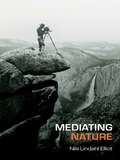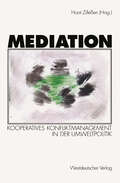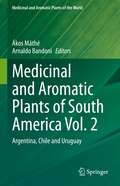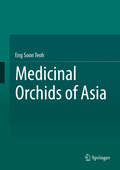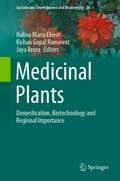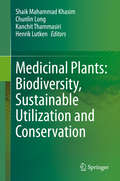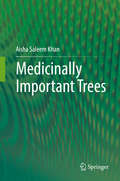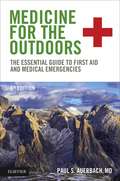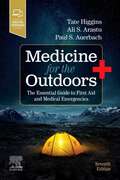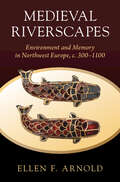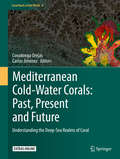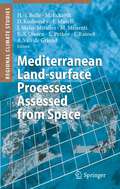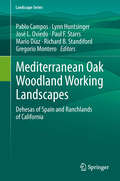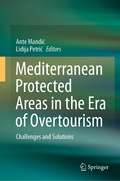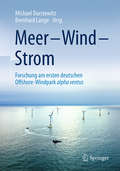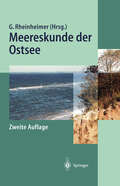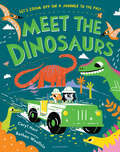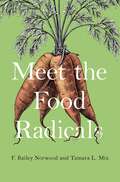- Table View
- List View
Mediating Nature: The Role of Technology in Ecological Literacy (Routledge Environmental Literature, Culture and Media)
by Sidney I. Dobrin Sean MoreyMediating Nature considers how technology acts as a mediating device in the construction and circulation of images that inform how we see and know nature. Scholarship in environmental communication has focused almost exclusively on verbal rather than visual rhetoric, and this book engages ecocritical and ecocompositional inquiry to shift focus onto the making of images. Contributors to this dynamic collection focus their efforts on the intersections of digital media and environmental/ecological thinking. Part of the book’s larger argument is that analysis of mediations of nature must develop more critical tools of analysis toward the very mediating technologies that produce such media. That is, to truly understand mediations of nature, one needs to understand the creation and production of those mediations, right down to the algorithms, circuit boards, and power sources that drive mediating technologies. Ultimately, Mediating Nature contends that ecological literacy and environmental politics are inseparable from digital literacies and visual rhetorics. The book will be of interest to scholars and students working in the fields of Ecocriticism, Ecocomposition, Media Ecology, Visual Rehtoric, and Digital Literacy Studies.
Mediating Nature: The Role of Technology in Ecological Literacy (Routledge Environmental Literature, Culture and Media)
by Sidney I. Dobrin Sean MoreyMediating Nature considers how technology acts as a mediating device in the construction and circulation of images that inform how we see and know nature. Scholarship in environmental communication has focused almost exclusively on verbal rather than visual rhetoric, and this book engages ecocritical and ecocompositional inquiry to shift focus onto the making of images. Contributors to this dynamic collection focus their efforts on the intersections of digital media and environmental/ecological thinking. Part of the book’s larger argument is that analysis of mediations of nature must develop more critical tools of analysis toward the very mediating technologies that produce such media. That is, to truly understand mediations of nature, one needs to understand the creation and production of those mediations, right down to the algorithms, circuit boards, and power sources that drive mediating technologies. Ultimately, Mediating Nature contends that ecological literacy and environmental politics are inseparable from digital literacies and visual rhetorics. The book will be of interest to scholars and students working in the fields of Ecocriticism, Ecocomposition, Media Ecology, Visual Rehtoric, and Digital Literacy Studies.
Mediating Nature (International Library of Sociology)
by Nils Lindahl ElliotMediating Nature provides a history of the present nature of mass mediation. It examines the ways in which a number of discourses, technologies and institutions have historically shaped the current ways of imagining nature in the mass media. Where much of the existing research treats mass mediation as a matter of media technologies, texts, or institutions, this text adopts a somewhat different approach: it considers mass mediation as a historical process by means of which the members of audiences and indeed the public more generally came to be incorporated as observers in, and of mass culture. This approach allows the book to investigate the roles that a wide range of genres relating to nature played in constructing senses of nature but also of mass culture itself. The genres include landscape paintings and gardens, modern zoos, photography, early cinema, nature essays, disaster and ‘animal attack’ films, as well as wildlife documentaries on television. The investigation develops what Lindahl Elliot describes as a ‘social semeiotic’ approach that combines the semeiotic theory of Charles Peirce with a historical sociology of cultural formations. Topical and timely, this fascinating book will be of great interest to students and researchers in the fields of media, sociology, cultural geography and environmental studies.
Mediating Nature (International Library of Sociology)
by Nils Lindahl ElliotMediating Nature provides a history of the present nature of mass mediation. It examines the ways in which a number of discourses, technologies and institutions have historically shaped the current ways of imagining nature in the mass media. Where much of the existing research treats mass mediation as a matter of media technologies, texts, or institutions, this text adopts a somewhat different approach: it considers mass mediation as a historical process by means of which the members of audiences and indeed the public more generally came to be incorporated as observers in, and of mass culture. This approach allows the book to investigate the roles that a wide range of genres relating to nature played in constructing senses of nature but also of mass culture itself. The genres include landscape paintings and gardens, modern zoos, photography, early cinema, nature essays, disaster and ‘animal attack’ films, as well as wildlife documentaries on television. The investigation develops what Lindahl Elliot describes as a ‘social semeiotic’ approach that combines the semeiotic theory of Charles Peirce with a historical sociology of cultural formations. Topical and timely, this fascinating book will be of great interest to students and researchers in the fields of media, sociology, cultural geography and environmental studies.
Mediation: Kooperatives Konfliktmanagement in der Umweltpolitik
by Horst ZilleßenIn keinem anderen Tätigkeitsfeld von Politik und Verwaltung entstehen so viele und erbitterte Konflikte mit Bürgerinnen und Bürgern wie im Umweltbereich. Politik und Verwaltung sind hier wie in der Umweltpolitik generell auf die Kooperation mit den betroffenen Bürgern, Gruppen und Organisationen angewiesen. In den letzen Jahren wählen sie dabei häufig das Verfahren der Mediation, bei dem ein neutraler und professioneller Konfliktmanager eingesetzt wird, um durch Kooperation von Betroffenen eine Problemlösung zu erreichen. Dieser Band gibt eine umfassende Übersicht über die Entstehung und Entwicklung des Mediationsverfahrens in den USA. Es beschreibt das politische, gesellschaftliche und rechtliche Umfeld für kooperatives Konfliktmanagement in der Bundesrepublik und zeigt, wie diese Verfahren politikwissenschaftlich zu analysieren und einzuordnen sind. An einem konkreten Beispiel wird verdeutlicht, wie Mediation in der Praxis ablaufen kann. Der Band dokumentiert die erste breit angelegte empirische Erfassung der inzwischen in Deutschland durchgeführten Verfahren und enthält auch eine umfassende Bibliographie zu Gesamtthematik sowie eine Liste der Adressen von Umweltmediatoren.
Medicinal and Aromatic Plants of South America Vol. 2: Argentina, Chile and Uruguay (Medicinal and Aromatic Plants of the World #7)
by Ákos Máthé Arnaldo BandoniThis volume, as the seventh of the series Medicinal and Aromatic Plants of the World, deals with the medicinal and aromatic plant (MAPs) treasures of the so-called Southern Cone, the three southernmost countries (Argentina, Chile and Uruguay) of South America. Similarly to the previous volumes of the series, the main focus is to collect and provide information on major aspects of botany, traditional usage, chemistry, production / collection practices, trade and utilization of this specific group of plants. The contributors, who are recognized professionals and specialist of the domain, have collected and present state of the art information on 41 species. Most of these are not only of interest from the scientific point of view, but hold also a potential for the prospective utilization of the decreasing, occasionally overexploited / endangered medicinal plant resources of this huge continent. The book is expected to serve as a source of information also on some less known or less studied species. As such the volume is expected to support future research and public health professionals.
Medicinal Orchids of Asia
by Eng Soon TeohThis unique book brings together a wealth of data on the botanical, ethno-medicinal and pharmacological aspects of over 500 species of Asian medicinal orchids. It starts off by explaining the role and limitations of complimentary and herbal medicines, and how traditional Asian medicine differs from Western, “scientific” medicine. The different Asian medical traditions are described, as well as their modes of preparing herbal remedies. The core of the book presents individual medicinal orchid species arranged by genera. Each species is identified by its official botanical name, synonyms, and local names. Its distribution, habitat and flowering season, uses and pharmacology are described. An overview sums up the research findings on all species within each genus. Clinical observations are discussed whenever available, and possible therapeutic applications are highlighted. The book closes with chapters on the conservation of medicinal orchids and on the role of randomized clinical trials.
Medicinal Plants: Domestication, Biotechnology and Regional Importance (Sustainable Development and Biodiversity #28)
by Halina Maria Ekiert Kishan Gopal Ramawat Jaya AroraMedicinal plant research is an evergreen subject. There is a tremendous increase in popularity of herbal medicine in traditional medicine, ethnomedicine, modern medicine and as over the counter food supplements. Even after this increased demand, supply is neither uniform nor assured as most of these plants are collected from wild. In developing countries of tropical and subtropical regions where majority of herbal drugs are produced, this is not organised sector making it vulnerable to several malpractices, hence standardization of all aspects required. This has also negative impact on biodiversity and conservation of plants as well as supply of uniform material. This book is aimed to provide up to date information about sustainable use of selected medicinal plants, their active ingredients and efforts made to domesticate them to ensured uniform supply. Development of agrotechnology, biotechnology and cultivation practices using conventional and non-conventional methods are presented. Where these efforts will lead the medicinal plant research and future perspective are discussed. The chapters are written by well recognised group leaders in working in the field. The book contains topics on general biology of medicinal plants, their sustainable use and, cultivation and domestication efforts. A uniform chapter structure has been designed to keep consistency. The book will be useful for academicians, agriculturists, biotechnologists and researcher, and industries involved in manufacturing herbal drugs and supplementary products.
Medicinal Plants: Biodiversity, Sustainable Utilization and Conservation
by Shaik Mahammad Khasim Kanchit Thammasiri Chunlin Long Henrik LutkenPlants have been a source of medicines and have played crucial role for human health. Despite tremendous advances in the field of synthetic drugs and antibiotics, plants continue to play a vital role in modern as well as traditional medicine across the globe. In even today, one-third of the world’s population depends on traditional medicine because of its safety features and ability to effectively cure diseases. This book presents a comprehensive guide to medicinal plants, their utility, diversity and conversation, as well as biotechnology. It is divided into four main sections, covering all aspects of research in medicinal plants: biodiversity and conservation; ethnobotany and ethnomedicine; bioactive compounds from plants and microbes; and biotechnology. All sections cover the latest advances. The book offers a valuable asset for researchers and graduate students of biotechnology, botany, microbiology and the pharmaceutical sciences. It is an equally important resource for doctors (especially those engaged in Ayurveda and allopathy); the pharmaceutical industry (for drug design and synthesis); and the agricultural sciences.
Medicinally Important Trees
by Aisha Saleem KhanThis book provides researchers and advanced students associated with plant and pharmaceutical sciences with comprehensive information on medicinal trees, including their identification, morphological characteristics, traditional and economic uses, along with the latest research on their medicinal compounds.The text covers the ecological distribution of over 150 trees, which are characterized mainly on the basis of their unique properties and phytochemicals of medicinal importance (i.e., anti-allergic, anti-diabetic, anti-carcinogenic, anti-microbial, and possible anti-HIV compounds). Due to the incredibly large diversity of medicinal trees, it is not possible to cover all within one publication, so trees with unique medicinal properties that are relatively more common in many countries are discussed here in order to make it most informative for a global audience.With over 100 illustrations taken at different stages of plant development, this reference work serves as a tool for tree identification and provides morphological explanations. It includes the latest botanical research, including biochemical advancements in phytochemistry techniques such as chromatographic and spectrometric techniques. In addition, the end of each chapter presents the most up-to-date references for further sources of exploration.
Medicine for the Outdoors E-Book: The Essential Guide to First Aid and Medical Emergencies (Lyons Press Ser.)
by Paul S. AuerbachSince 1986, Medicine for the Outdoors has been hailed as the definitive take-along manual on the subject. Packed with step-by-step instructions and how-to explanations, this updated edition tells you the best way to respond to just about any medical problem. Logically organized, simple-to-understand enhanced illustrations and an increased focus on new topics mean this medical reference book may literally save your life. Whether you’re venturing into mountains, deserts, forests, or out to sea, it belongs in your pack! Examine the most diverse and comprehensive coverage of medical conditions related to the outdoors.Be guided through logical and complete explanations of every topic.Enhance your understanding with descriptive material including numerous drawings and instructions.Research recommendations for injury and illness prevention.Locate answers quickly with a helpful comprehensive index.Clearly visualize how to perform specific treatments, such as the use of a SAM® splint, with an increased number of helpful illustrations. Stay abreast of the latest in emergency medicine care, including new antibiotics, medicines, products to control bleeding, and today's most common infectious disease threats.Enhance your understanding of Lyme disease; water disinfection; emerging diseases (including West Nile Virus); and how to seek safety and act during natural disasters.Take advantage of Dr. Auerbach’s expert guidance with revised recommendations on high-altitude problems, drowning, airways management, toxic plants, and snake bites.Access new appendices covering AIDS/HIV transmission, expanded treatment instructions, global conflict guidelines (including terrorism), and canine medicine. Consult this title on your favorite e-reader.
Medicine for the Outdoors E-Book: The Essential Guide to First Aid and Medical Emergencies
by Paul S. Auerbach Tate Higgins Ali S. ArastuFor nearly 40 years, Medicine for the Outdoors: The Essential Guide to First Aid and Medical Emergencies has been the take-along manual of choice for anyone venturing into the mountains, forest, desert, or on water. This essential guide provides highly illustrated, easy-to-follow guidance on immediate stabilization and treatment of persons with virtually any possible medical problem—designed for on-the-spot use when higher-level medical care is not accessible. Written by experts in outdoor medicine, this updated edition helps you manage any situation until medical personnel can take over. Covers key information on a wide range of disorders related to specific environments, including natural disasters, high-altitude problems, water-related incidents, heat- and cold-related illnesses, and wildland fires. Provides easy-to-understand recommendations for dealing with animal attacks, venomous wildlife, wild plant and mushroom poisoning, minor and major medical problems, infectious diseases, water disinfection, and severe bleeding. Discusses key topics, including antibiotics, medicines, opioid overdose treatment, wound closure techniques, severe bleeding, spinal assessment and immobilization, tourniquets, the use of a Gamow bag for severe altitude illness, splinting, dental emergencies, disaster preparedness, global conflict guidelines, canine medicine, today’s infectious disease threats, and much more. Includes up-to-date guidelines, even more helpful illustrations and diagrams, and a new chapter: Patient Assessment: A Structured Approach to Emergencies in the Outdoors. Includes advanced topics valuable to physicians and expedition medical staff at all levels of training and experience.
Medieval Riverscapes: Environment and Memory in Northwest Europe, c. 300–1100 (Studies in Environment and History)
by null Ellen F. ArnoldFishermen, monks, saints, and dragons met in medieval riverscapes; their interactions reveal a rich and complex world. Using religious narrative sources to evaluate the environmental mentalities of medieval communities, Ellen F. Arnold explores the cultural meanings applied to rivers over a broad span of time, ca. 300-1100 CE. Hagiographical material, poetry, charters, chronicles, and historiographical works are explored to examine the medieval environmental imaginations about rivers, and how storytelling and memory are connected to lived experiences in riverscapes. She argues that rivers provided unique opportunities for medieval communities to understand and respond to ecological and socio-cultural transformations, and to connect their ideas about the shared religious past to hopes about the future.
Mediterranean Cold-Water Corals: Understanding the Deep-Sea Realms of Coral (Coral Reefs of the World #9)
by Covadonga Orejas Carlos JiménezWhat do we know about Mediterranean Cold (Deep)-Water coral ecosystems? In this book, specialists offer answers and insights with a series of chapters and short papers about the paleoecology, biology, physiology and ecology of the corals and other organisms that comprise these ecosystems. Structured on a temporal axis—Past, Present and Future—the reviews and selected study cases cover the cold and deep coral habitats known to date in the Mediterranean Basin. This book illustrates and explains the deep Mediterranean coral habitats that might have originated similar thriving ecosystems in today’s Atlantic Ocean.
Mediterranean Land-surface Processes Assessed from Space (Regional Climate Studies)
by Hans-Jürgen Bolle Matthias Eckardt Dirk Koslowsky Fabio Maselli Joaquin Melia Miralles Massimo Menenti Folke-Sören Olesen Ljiljana Petkov S. Ichtiaque Rasool Adriaan GriendThis is a detailed description of the steps leading from raw signals measured in space, to calibrated comparable long term data sets, to its final form: useful information for user communities. Examples of applications and data validations result from different investigations in the Mediteranean area. An appendix summarizes useful formulas of the evaluation of satellite data.
Mediterranean Oak Woodland Working Landscapes: Dehesas of Spain and Ranchlands of California (Landscape Series #16)
by Pablo Campos, Lynn Huntsinger, Jose Luis Oviedo Pro, Paul F Starrs, Mario Diaz, Richard B Standiford and Gregorio MonteroThe oak tree was a boon companion as humans expanded their presence across much of the globe. While oak woodlands (Quercus spp.) come today in stunningly diverse forms, the stately dehesas of Spain and the dramatic oak-dominated ranchlands of California are working landscapes where cultivation and manipulation for a couple of millennia have shaped Mediterranean-type ecosystems into a profoundly modified yet productive environment that is sought-after by every manner of species.The grazing of wildlife and livestock in oak woodlands yields a remarkable plant and animal biodiversity, creating a mosaic of habitats and visually pleasing savannas. Added products unique to Spain such as Iberian pigs and cork, and in California multiple landowner benefits, include valued ecosystem services that allow owners, visitors, and conservation supporters to experience the benefits of woodland life. With its 15 chapters a decade in the making, this handsomely illustrated book covers key topics in oak woodland policy, ecology, and management in Spain and California, presenting new research results and reviewing an existing expert literature.
Mediterranean Protected Areas in the Era of Overtourism: Challenges and Solutions
by Ante Mandić Lidija PetrićThis book comprises studies that reflect on various influences of excessive tourism development in protected areas, and solutions designed and initiated to mitigate such challenges. A large proportion of tourism in Mediterranean destinations constitutes nature-based tourism, in particular, tourism in parks and protected areas. As a destination experiences higher intensity and density of tourism, the potential conflict between maintaining a healthy natural environment and economic development also increases. This has urged planners and decision-makers to devise and adopt innovative approaches that seek to strike a balance between tourism development and nature conservation. This book demonstrates the importance of collaboration across and beyond disciplines and of all groups of stakeholders for maximization of societal impacts and tourism-related benefits.
Meer – Wind – Strom: Forschung am ersten deutschen Offshore-Windpark alpha ventus
by Michael Durstewitz Bernhard LangeDie Offshore-Windenergie wird in der zukünftigen Stromversorgung eine entscheidende Rolle spielen. Diese Entwicklung steht aber gerade erst an ihrem Anfang. Ein großes Team aus Forschung, Industrie, Verwaltung und Politik hat sich deshalb zum Ziel gesetzt, die aktuellen und grundlegenden Fragen der Offshore-Windenergienutzung zu bearbeiten. Über 100 Forscher der RAVE-Initiative (Research at alpha ventus) arbeiteten in interdisziplinären Forschungsprojekten daran, unser Wissen zu erweitern und anwendungsorientierte Lösungen für die Offshore-Windenergie zu finden. Damit tragen sie dazu bei, die Offshore-Windenergie als eine zuverlässige, nachhaltige und kostengünstige Energiequelle auf Dauer zu etablieren. Im Testfeld alpha ventus, Deutschlands erstem Offshore-Windpark, wurden die Voraussetzungen für diese Forschung geschaffen. Der Windpark wurde mit umfangreicher Messtechnik ausgestattet: Über 1200 Messgrößen werden aufgezeichnet und sind über ein zentrales Forschungsarchiv zugänglich. Die Forscher der RAVE-Initiative haben somit die weltweit einmalige Möglichkeit, eine Vielzahl von Messdaten aus einem operativen Windpark zu nutzen. Die Auswertungen erfolgen dezentral an Forschungseinrichtungen im gesamten Bundesgebiet. Über Ziele, Methoden und Schwierigkeiten der RAVE-Forschungsprojekte wird in allgemeinverständlicher Form berichtet und die Ergebnisse sowie ihre Bedeutung für die weitere Nutzung der Offshore-Windenergie dargestellt.Der Leser erhält somit einen Überblick über den aktuellen Stand der Offshore-Windenergieforschung und die Ergebnisse der Forschungsarbeiten.
Meereskunde der Ostsee
by D. NehringUm die Ostsee als Lebensraum zu erhalten, ist eine umfassende Analyse und ein ständiges Überwachen der ökologischen Parameter nötig.Renommierte Forscher der großen Ostseeinstitute beschreiben in der "Meereskunde der Ostsee" alle wesentlichen Aspekte, die das Ökosystem Ostsee ausmachen: Klima, Geologie, Pflanzen, Tiere, industrielle Nutzung und Belastung, mögliche Schutzmaßnahmen. Das Thema wird gut verständlich dargestellt und durch zahlreiche, zum Teil farbige Abbildungen veranschaulicht.Nicht nur Fachkundigen, sondern auch Laien und "Ostseeliebhabern" wird mit diesem Buch aktuelles Hintergrundwissen vermittelt.
Meeresnaturschutz, Erhaltung der Biodiversität und andere Herausforderungen im "Kaskadensystem" des Rechts: Festgabe zur Emeritierung von Detlef Czybulka (Schriftenreihe Natur und Recht #13)
by Thomas Bosecke Peter Kersandt Katrin TäuferDie Herausgeber und Autoren der Festgabe ehren einen Juristen, Wissenschaftler und Hochschullehrer, der maßgeblich zur Ökologisierung und Internationalisierung der Umweltrechtswissenschaft beigetragen hat. Im Mittelpunkt stehen die rechtlichen Anforderungen an den Schutz der biologischen Vielfalt, die Nutzung des Meeres als natürliche Nahrungsquelle und für die Aquakultur, die jüngste Reform des Naturschutz- und des Wasserrechts sowie CCS als neue Klimaschutztechnologie. Weitere Beiträge befassen sich mit der marinen Raumordnung, der Alpenkonvention, dem Reformbedarf in der Umweltverwaltung sowie dem nachhaltigen Konsum im Lichte von Verbraucherpolitik und -recht. Die Festgabe spiegelt in ihrer thematischen Breite einen wichtigen Teil des wissenschaftlichen Wirkens Detlef Czybulkas wider. Sie bietet zugleich konkrete Lösungsansätze für aktuelle Herausforderungen im Recht des Meeresnaturschutzes, der Erhaltung der Biodiversität und des Klimaschutzes.
Meerkat Manor: Flower Of The Kalahari
by Tim Clutton-BrockThe life of the Meerkats - from the highly successful TV series, and soon to be released major feature filmMEERKAT MANOR is the true-life story of Flower, the heroine of the successful television series, and the dominant female of Whiskers group. Through words and superb photographs, the reader becomes closely involved in the life-or-death struggles, just like a soap opera, of this curiously attractive tribe. MEERKAT MANOR not only describes what meerkats do, but explains why they do it, providing important insights into the working of other animal societies, including humans.'They look cute and their teamwork has led some to suggest they are ideal role models for humans, but ... if MEERKAT MANOR is billed as a soap opera, it is one scripted by Quentin Tarantino' Mail on Sunday.
Meerkats (Nature's Children Ser.)
by Tim HarrisWhere do meerkats live? What do meerkats eat? How big are meerkats? Find out the answers to these questions and learn all about the physical characteristics, behavior, and habitats of meerkats.
Meet the Dinosaurs (Meet the . . .)
by Caryl HartZOOOOM! We're off on an exciting journey into the past to meet the amazing dinosaurs that once roamed the earth. Join in with the rhymes and get ready to spot all the friendly (and not so friendly!) dinosaurs, from the huge Brontosaurus and amazing Diplodocus to the speedy Velociraptor and scary T-Rex. Little ones will have an action-packed time (and be back in time for bed!) in this fun and fact-packed picture book. This bold, bright follow-up to the acclaimed picture books Meet the Planets, Meet the Oceans and Meet the Weather is filled with ALL your favourite dinos. Combining STEM learning with a rhyming twist, it's perfect for all would-be palaeontologists.
Meet the Food Radicals
by F. Bailey Norwood Tamara L. MixThe food system has changed considerably in the last century. Horsepower was replaced by machine, better crop breeding programs helped usher in the Green Revolution, and problems of malnutrition began to run parallel with those of obesity. Despite changes, many of the problems we face remain the same. Farms continue to lose soil, and low income households still have difficulty acquiring healthy food. Add to these challenges a host of new ones. Globalization has caused some agricultural communities to feel threatened. Everyone recognizes problems of malnutrition, obesity and food sustainability, but many disagree on solutions. One thing is certain: confronting both familiar and new challenges will lead to radical changes in the food system. Though the exact form of radical change is unknown, this book looks to a host of candidates by interviewing the people who champion them. We are winning the battle against soil erosion through new no-till farming methods. Progress is being made in food sustainability by a spectrum of new innovations, but also a return to traditional farming techniques. New innovations include robots on the farm, advances in molecular biology, and alternative protein sources. As we embrace the farming strategies of our ancestors, we see farms returning to polycultures, local food systems, and food sovereignty. This book gains insight from interviews with twenty-seven individuals who are either creating or proposing radical changes in how food is produced and distributed. An eclectic group ranging from farmers to activists to spiritual gurus, they are the most interesting people you have never met. By getting to know each "radical" personally we can better access their voices and visions to understand both the problems and likely solutions to today's most pressing food problems.
Meet the Food Radicals
by F. Bailey Norwood Tamara L. MixThe food system has changed considerably in the last century. Horsepower was replaced by machine, better crop breeding programs helped usher in the Green Revolution, and problems of malnutrition began to run parallel with those of obesity. Despite changes, many of the problems we face remain the same. Farms continue to lose soil, and low income households still have difficulty acquiring healthy food. Add to these challenges a host of new ones. Globalization has caused some agricultural communities to feel threatened. Everyone recognizes problems of malnutrition, obesity and food sustainability, but many disagree on solutions. One thing is certain: confronting both familiar and new challenges will lead to radical changes in the food system. Though the exact form of radical change is unknown, this book looks to a host of candidates by interviewing the people who champion them. We are winning the battle against soil erosion through new no-till farming methods. Progress is being made in food sustainability by a spectrum of new innovations, but also a return to traditional farming techniques. New innovations include robots on the farm, advances in molecular biology, and alternative protein sources. As we embrace the farming strategies of our ancestors, we see farms returning to polycultures, local food systems, and food sovereignty. This book gains insight from interviews with twenty-seven individuals who are either creating or proposing radical changes in how food is produced and distributed. An eclectic group ranging from farmers to activists to spiritual gurus, they are the most interesting people you have never met. By getting to know each "radical" personally we can better access their voices and visions to understand both the problems and likely solutions to today's most pressing food problems.

